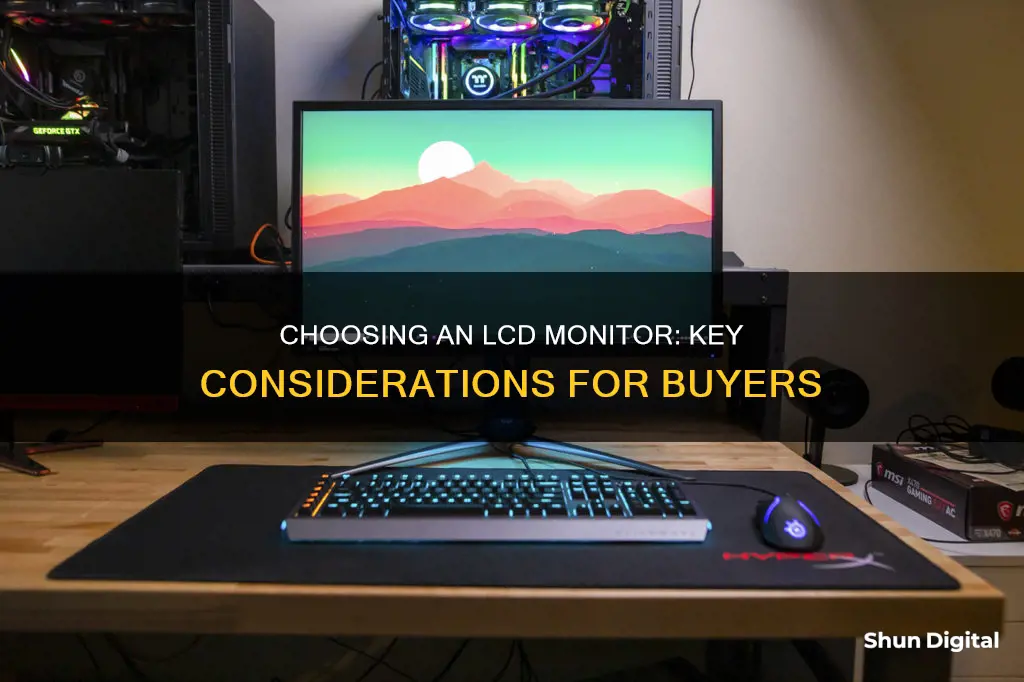
When buying an LCD monitor, it's important to consider the purpose of the monitor, budget, energy efficiency, and picture quality.
LCD monitors are available in a range of sizes and can be used for general computing tasks, gaming, graphic design, or video editing. They are usually more affordable than LED monitors and are sufficient for everyday activities such as web browsing, social media, and online bill payments.
For more specific use cases, there are certain features that may be important to look out for. For example, photographers, graphic designers, and video production artists require monitors with larger screens, high resolutions, deep blacks, accurate colours, and wide viewing angles. Gamers, on the other hand, should opt for monitors with fast refresh rates, low response times, and high resolutions to keep up with the speed and intensity of modern games.
Additionally, it's worth noting that while LCD stands for Liquid Crystal Display, not all LCD monitors use liquid crystals for backlighting. LED monitors, which are a type of LCD monitor, use Light Emitting Diodes (LEDs) for backlighting, resulting in superior picture quality, improved energy efficiency, and longer lifespans.
| Characteristics | Values |
|---|---|
| Monitor type | TN, IPS, VA, OLED, QLED |
| Monitor size | 24-inch, 27-inch, 32-inch, ultrawide |
| Resolution | 1080p, 1440p, 4K |
| Refresh rate | 60Hz, 144Hz, 240Hz, 360Hz, 500Hz |
| Adaptive sync | AMD FreeSync, Nvidia G-Sync, VESA AdaptiveSync |
| Monitor stand | Height and tilt adjustment, swivel, pivot, VESA mount |
| Monitor HDR | OLED, Mini-LED |
| Monitor features | Speakers, USB-C, USB-C PD |
What You'll Learn

Backlighting: CCFL vs LED
When it comes to LCD monitors, there are two main types of backlighting to choose from: CCFL (cold cathode fluorescent lamp) and LED (light-emitting diode). Both options have their pros and cons, and understanding the differences between them can help you make an informed decision about which type of LCD monitor is right for your needs.
CCFL Backlighting
CCFL backlighting has been the most commonly used form of backlight for many years. This means that their cost is considerably lower, making them a budget-friendly option. CCFL backlights also have a long lifespan, making them a trusted choice for many manufacturers. However, CCFL backlights have higher power consumption, which can lead to increased heat generation. CCFL monitors are also proportionally thicker and heavier compared to LED monitors.
LED Backlighting
LED backlighting is a newer technology that offers improved picture quality. LEDs are capable of higher brightness than CCFLs, resulting in crisper images. LED monitors also offer better energy efficiency, consuming up to 50% less power than conventional CCFL monitors. This lower power consumption also leads to significantly less heat generation. Additionally, LED screens allow for more precise control over brightness, with the ability to dim specific areas of the screen.
Comparison
While CCFL backlighting may be more cost-effective, LED backlighting offers several advantages in terms of image quality and energy efficiency. LED monitors provide higher brightness, improved contrast, and more precise control over brightness levels. On the other hand, CCFL monitors have a longer history of use and are more affordable. Ultimately, the decision between CCFL and LED backlighting depends on your specific needs and budget.
Monitors: Nintendo vs Unisystem, Size Comparison
You may want to see also

Resolution: 1080p, 1440p or 4K?
Resolution: 1080p, 1440p, or 4K?
When looking for a new LCD monitor, one of the first things you'll see about its specifications is its resolution, but how does that affect your buying decision? While many different resolutions are available, this article will break down the differences between the most common ones: 1080p, 1440p, and 4K, and help you decide which one is right for you.
1080p
1080p monitors are the lowest resolution of the three and are considered the standard for most low-budget consumer-grade monitors. They are ideal for budget-conscious gamers due to their low cost and high refresh rates. 1080p monitors are also great for straightforward productivity tasks. However, they struggle to display higher-resolution media content correctly.
Pros of 1080p Monitors:
- Cheaper than 1440p and 4K monitors.
- Easier to produce and don't require robust components.
- Can reach high refresh rates due to the relatively low resolution.
- Don't require a powerful graphics card when gaming on a PC.
Cons of 1080p Monitors:
Cannot display visuals of higher resolutions accurately. For example, a 4K movie will only be displayed in 1080p.
1440p
1440p monitors offer a balanced middleground and are considered the "sweet spot" for work and play. They provide drastically crisper visuals and more screen space since the pixels are more densely packed. 1440p monitors can also achieve high refresh rates but require a more powerful graphics card than 1080p screens. While they cannot display 4K content at full quality, the quality is noticeably higher than a 1080p screen.
Pros of 1440p Monitors:
- Higher pixel density results in nicer visuals.
- Extra screen space is useful, especially when working on multiple tasks simultaneously.
- Can reach high refresh rates.
Cons of 1440p Monitors:
- Media at 1080p resolution and lower will look blurry as the display fills in gaps with information from surrounding pixels.
- Cannot display 4K media at full quality.
- Requires a better graphics card for gaming than a 1080p monitor.
4K
4K monitors offer four times the number of pixels as 1080p monitors, resulting in excellent picture quality and plenty of screen space. However, they are more expensive than their lower-resolution counterparts and require a very powerful graphics card, especially for gaming purposes. Additionally, 4K monitors struggle to display low-resolution media well, as it tends to look stretched out across all the pixels.
Pros of 4K Monitors:
- Fully display 4K media in full accuracy, resulting in crisp visuals for media consumption.
- Plenty of screen space, which is useful for extensive graphic work.
Cons of 4K Monitors:
- Lower-resolution media will look stretched and blocky due to the lack of visual information.
- More expensive than 1080p and 1440p monitors.
- Cannot reach the same high refresh rates as higher-end 1080p and 1440p monitors.
- Require a powerful graphics card for gaming, or performance issues will occur.
So, Which Resolution Is Right for You?
The answer depends on your personal preferences and how you plan to use the monitor. If you are a gamer on a budget or primarily use your monitor for gaming, a 1080p monitor is a good choice due to its low cost and high refresh rates. If you need a versatile monitor for both work and play, a 1440p monitor strikes a balance between good gaming performance and excellent image quality. If you crave sharp image and text clarity and don't mind the higher cost, a 4K monitor is the way to go.
Plugging Headphones into Your ASUS Monitor: A Simple Guide
You may want to see also

Panel type: TN, VA or IPS?
When shopping for an LCD monitor, you'll likely come across three main panel types: twisted nematic (TN), vertical alignment (VA), and in-plane switching (IPS). Each panel type has its own advantages and disadvantages, so choosing the right one will depend on your specific needs and use case.
Twisted Nematic (TN) Panels
TN panels are known for their fast response times and high refresh rates, making them a popular choice for gaming monitors. They are usually the most affordable option and are often used in basic entry-level monitors. However, TN panels have limited colour reproduction and poor viewing angles, which can cause colour shift and image fade when viewed from off-centre.
Vertical Alignment (VA) Panels
VA panels offer improved colour reproduction and viewing angles compared to TN panels. They have excellent contrast ratios, making them a great choice for HDR content. VA panels are commonly found in curved monitors and are often used in TVs. While VA panels are not as fast as TN panels, they are still suitable for gaming and can offer excellent motion clarity.
In-Plane Switching (IPS) Panels
IPS panels are known for their superior colour reproduction and wide viewing angles, making them ideal for artists, media viewing, and shared viewing experiences. Modern IPS panels can also support fast response times and high refresh rates, making them a good choice for gamers. However, IPS panels tend to have disappointing contrast and black levels, which can make them appear hazy when viewing dark images in a dark room.
Finding Wallpaper Size for a Three-Monitor Setup
You may want to see also

Size: 24-inch, 27-inch or 32-inch?
The size of an LCD monitor is an important factor to consider when making a purchase, as it will depend on your needs and requirements. The most popular sizes available are 24-inch, 27-inch, and 32-inch. Here's a detailed comparison between these three sizes to help you make an informed decision:
24-Inch Monitors
24-inch monitors are typically suitable for casual users and are often more affordable than larger options. They are ideal for reading text, writing, and editing documents and images. A 1920 x 1080 resolution, also known as 1080p or Full HD, works best with this size. The standard level of scaling for text and icons is generally large enough for comfortable viewing and browsing. Additionally, 24-inch monitors are space-saving and can be easily incorporated into a multi-monitor setup for multitasking.
27-Inch Monitors
27-inch monitors offer a balance between size and functionality. They are recommended for more serious uses, such as photo editing, programming, and gaming. This size provides ample screen real estate and a reasonable price tag. A 2560 x 1440 resolution, or 1440p, is ideal for 27-inch monitors, offering increased sharpness and a great experience for gaming and media consumption. The text and icons may appear smaller, but scaling options are available to suit your comfort level.
32-Inch Monitors
32-inch monitors are ideal for professional editing, gaming, and other specialised tasks that require a large display area. They offer ample space for multiple windows and tabs, making them suitable for programming and video editing. However, they may face compatibility issues with certain gaming software and can be more expensive. Additionally, 32-inch monitors require a larger viewing distance, which may not be ideal for all users or setups.
In summary, the choice between 24-inch, 27-inch, and 32-inch monitors depends on your specific needs. If you're a casual user, a 24-inch monitor will suffice, while professionals and gamers may prefer the larger sizes. A 27-inch monitor strikes a good balance between size and functionality, offering a versatile option for various tasks.
Protecting Your Data: Stop ISPs Monitoring Your Usage
You may want to see also

Refresh rate: 60Hz, 144Hz or 240Hz?
When it comes to choosing the right refresh rate for an LCD monitor, there are typically three common options to choose from: 60Hz, 144Hz, and 240Hz. Each option has its own advantages and is suited for different use cases.
The 60Hz refresh rate is the most common and affordable option. It offers good performance for Netflix viewing and is suitable for lower-end gaming machines or those who prefer higher resolutions without breaking the bank. A 60Hz monitor works well for office work and productivity tasks, and you likely won't see much benefit from a higher refresh rate for these use cases.
The 144Hz refresh rate is a popular option for gaming monitors as it offers amazingly smooth gameplay. The higher refresh rate results in reduced blur, leading to a sharper picture and improved ability to make out details in videos or games with fast-moving objects. This is especially noticeable for text, where scrolling or dragging windows feels much smoother on a 144Hz monitor.
The 240Hz refresh rate is the top-of-the-line option, offering incredibly smooth gameplay and producing essentially no motion blur. It is generally the highest refresh rate available on the market and is aimed at those who want the absolute best gaming experience and are willing to spend extra.
For most gamers, the upgrade from 60Hz to 144Hz will be a noticeable and worthwhile improvement. The jump from 144Hz to 240Hz is less significant and may be approaching the point of diminishing returns. However, for those seeking the very best performance, 240Hz monitors are the way to go.
Monitoring Hotspot Usage: A Comprehensive Guide to Tracking Data
You may want to see also
Frequently asked questions
All LED monitors are LCD monitors, but not all LCD monitors are LEDs. The difference lies in their backlighting technology. LCD monitors use cold cathode fluorescent lamps (CCFLs) for backlighting, while LED monitors use light-emitting diodes (LEDs). LED monitors usually offer superior picture quality, but they come in varying backlight configurations, such as full-array backlighting and edge lighting.
LCD monitors use liquid crystals to control light passage and are typically thinner and more energy-efficient than older CRT monitors. They have good colour reproduction and brightness but may struggle with producing true blacks. LCD monitors are generally less expensive than LED monitors.
LED monitors use LED backlighting technology, making them superior in terms of LED display with easier maintenance, better colour accuracy, and improved visual clarity, and longer lifespans. They offer better contrast ratios, deeper blacks, and wider viewing angles. LED monitors are more energy-efficient than LCD monitors, consuming about 20-30% less power.







